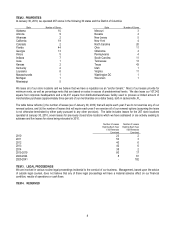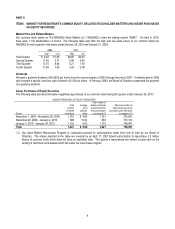Stein Mart 2009 Annual Report Download - page 20
Download and view the complete annual report
Please find page 20 of the 2009 Stein Mart annual report below. You can navigate through the pages in the report by either clicking on the pages listed below, or by using the keyword search tool below to find specific information within the annual report.Store Closing Costs. We record costs associated with store closing activities when they are incurred, generally the cease-use date.
Lease termination costs are recorded net of estimated sublease income that could reasonably be obtained for the properties. In the
event we are not successful in subleasing closed store locations, additional store closing costs may be recorded.
Insurance Reserves. We use a combination of insurance and self-insurance for various risks including workers’ compensation,
general liability and associate-related health care benefits, a portion of which is paid by the covered employees. We are responsible
for paying the claims that are less than the insured limits. The reserves recorded for these claims are estimated actuarially, based on
claims filed and claims incurred but not reported. These reserve estimates are adjusted based upon actual claims filed and settled.
The estimated accruals for these reserves could be significantly affected if future claims differ from historical trends and other
actuarial assumptions. As of January 30, 2010 and January 31, 2009, insurance reserves of $16.3 million and $16.4 million,
respectively, were included in accrued liabilities. Adjustments to earnings resulting from changes in trends and other actuarial
assumptions have not been significant in 2009, 2008 and 2007.
Valuation Allowance for Deferred Tax Assets. Income tax accounting guidance requires that companies assess whether valuation
allowances should be established against their deferred tax assets based on consideration of all available evidence using a "more
likely than not" standard. In making such assessments, significant weight is to be given to evidence that can be objectively verified. A
company's current or previous losses are given more weight than its future outlook.
During the fourth quarter of 2008, we established a valuation allowance against deferred tax assets because 2008 operating results
produced a cumulative three-year loss, which is considered a significant factor that is difficult to overcome when determining if a
valuation allowance is required. Although we were profitable in 2009, we remain in a cumulative three-year loss. We perform a
quarterly assessment of net deferred tax assets and plan to carry a valuation allowance until such time that positive evidence is
sufficient to justify realization. The valuation allowance was $16.7 million and $19.0 million at January 30, 2010 and January 31,
2009, respectively.
Income Tax Reserves. We record liabilities for uncertain tax positions related to federal and state income taxes. These liabilities
reflect our best estimate of our ultimate income tax liability based on the tax code, regulations, and pronouncements of the
jurisdictions in which we do business. Estimating our ultimate tax liability involves significant judgments regarding the application of
complex tax regulations across many jurisdictions. If actual results differ from estimated results, our effective tax rate and tax
balances could be affected. As such, these estimates may require adjustment in the future as additional facts become known or as
circumstances change.
For a complete listing of our significant accounting policies, see Note 1 to the Notes to Consolidated Financial Statements.
Recent Accounting Pronouncements
In June 2009, the Financial Accounting Standards Board (“FASB”) issued guidance which establishes the FASB Accounting
Standards Codification (“ASC”) as the source of authoritative GAAP recognized by the FASB to be applied by nongovernmental
entities. Rules and interpretive releases of the Securities and Exchange Commission (“SEC”) under authority of federal securities
laws are also sources of authoritative GAAP for SEC registrants. This guidance, which was incorporated into ASC Topic 105,
Generally Accepted Accounting Principles, is effective for interim and annual periods ending after September 15, 2009. The adoption
of the guidance during our third quarter of 2009 changed certain disclosure references to U.S. GAAP, but did not have any other
impact on our consolidated financial statements.
In October 2009, the FASB issued guidance impacting the determination of when individual deliverables included in an arrangement
with multiple deliverables may be treated as separate units of accounting. The guidance, which was incorporated into ASC Topic 605,
Revenue Recognition, eliminates the residual method of allocation for multiple-deliverable revenue arrangements, and requires that
arrangement consideration be allocated at the inception of an arrangement to all deliverables using the relative selling price method.
This guidance is effective for fiscal years beginning on or after June 15, 2010, however early adoption is permitted. We use this
guidance to account for our Co-brand Credit Card Consumer Program Agreement and we do not anticipate that adoption of this
guidance will have a material effect on our consolidated financial statements.
Effective February 1, 2009, we adopted the fair value measurement guidance as required by ASC Topic 820, Fair Value
Measurements and Disclosures, as it relates to nonfinancial assets and liabilities that are recognized or disclosed at fair value in the
financial statements on a non-recurring basis. The adoption of this guidance had no impact on our consolidated financial statements.
18
























